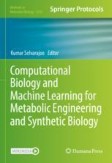Search
Search Results
-
Homology Modeling of Transporter Proteins
Membrane transporter proteins are divided into channels/pores and carriers and constitute protein families of physiological and pharmacological...
-
The Plant DNA C-Values Database: A One-Stop Shop for Plant Genome Size Data
Genome size is a plant character with far-reaching implications, ranging from impacts on the financial and computing feasibility of sequencing and...
-
Computational Methods to Predict Intrinsically Disordered Regions and Functional Regions in Them
Intrinsically disordered regions (IDRs) are protein regions that do not adopt fixed tertiary structures. Since these regions lack ordered...
-
Protein Homology Modeling for Effective Drug Design
The effective drug design, especially for combating the multi-drug-resistant bacterial pathogens, requires more and more sophisticated procedures to...
-
Modeling of SARS-CoV-2 Virus Proteins: Implications on Its Proteome
COronaVIrus Disease 19 (COVID-19) is a severe acute respiratory syndrome (SARS) caused by a group of beta coronaviruses, SARS-CoV-2. The SARS-CoV-2...
-
Resolving Crosstalk Between Signaling Pathways Using Mathematical Modeling and Time-Resolved Single Cell Data
Crosstalk between signaling pathways can modulate the cellular response to stimuli and is therefore an important part of signal transduction. For a...
-
Integrating Multiple Quantitative Proteomic Analyses Using MetaMSD
MetaMSD is a proteomic software that integrates multiple quantitative mass spectrometry data analysis results using statistical summary combination...
-
Computational Methods for the Design of Recombinase Logic Circuits with Adaptable Circuit Specifications
Synthetic biology aims at engineering new biological systems and functions that can be used to provide new technological solutions to worldwide...
-
Fluorescence Lifetime Imaging Microscopy of Biomolecular Condensates
Biomolecular condensates of ribonucleoproteins (RNPs) such as the transactivation response element (TAR) DNA-binding protein 43 (TDP-43) arise from...
-
Quantification of LINE-1 RNA Expression from Bulk RNA-seq Using L1EM
LINE-1 retrotransposons have the potential to cause DNA damage, contribute to genome instability, and induce an interferon response. Thus, accurate...
-
Genetic Knockout of TE Insertions by CRISPR-Cas9
Transposable elements (TEs) are abundant in the genome, and specific insertions may be co-opted to act as coding or noncoding functional elements....
-
Computational Random Mutagenesis to Investigate RAS Mutant Signaling
This chapter describes how mathematical models can be used to investigate the possible range of behaviors for mutant forms of a protein. A...
-
Meta-Dynamic Network Modelling for Biochemical Networks
ODE modelling requires accurate knowledge of parameter and state variable values to deliver accurate and robust predictions. Parameters and state...
-
Investigating Pangenome Graphs Using Wheat Panache
Pangenome graphs quickly become the central data structure representing the diversity of variation we see across related genomes. Pangenome graphs...
-
First Update to B-Chrom: A Database on B-Chromosomes
The supernumerary mostly dispensable B chromosomes are nuclear components of about 15% of eukaryotic phyla. For a long time, B chromosomes have been...
-
Fast, Free, and Flexible Peptide and Protein Quantification with FlashLFQ
The rapid and accurate quantification of peptides is a critical element of modern proteomics that has become increasingly challenging as proteomic...
-
Computational Methods and Deep Learning for Elucidating Protein Interaction Networks
Protein interactions play a critical role in all biological processes, but experimental identification of protein interactions is a time- and...
-
Designing a Model-Driven Approach Towards Rational Experimental Design in Bioprocess Optimization
To enable a more rational optimization approach to drive the transition from lab-scale to large industrial bioprocesses, a systematic framework...
-
Field-Theoretic Simulation Method to Study the Liquid–Liquid Phase Separation of Polymers
Liquid–liquid phase separation (LLPS) is a process that results in the formation of a polymer-rich liquid phase coexisting with a polymer-depleted...
-
Measurement of Protein and Nucleic Acid Diffusion Coefficients Within Biomolecular Condensates Using In-Droplet Fluorescence Correlation Spectroscopy
Liquid-liquid phase separation of protein and RNA complexes into biomolecular condensates has emerged as a ubiquitous phenomenon in living systems....
